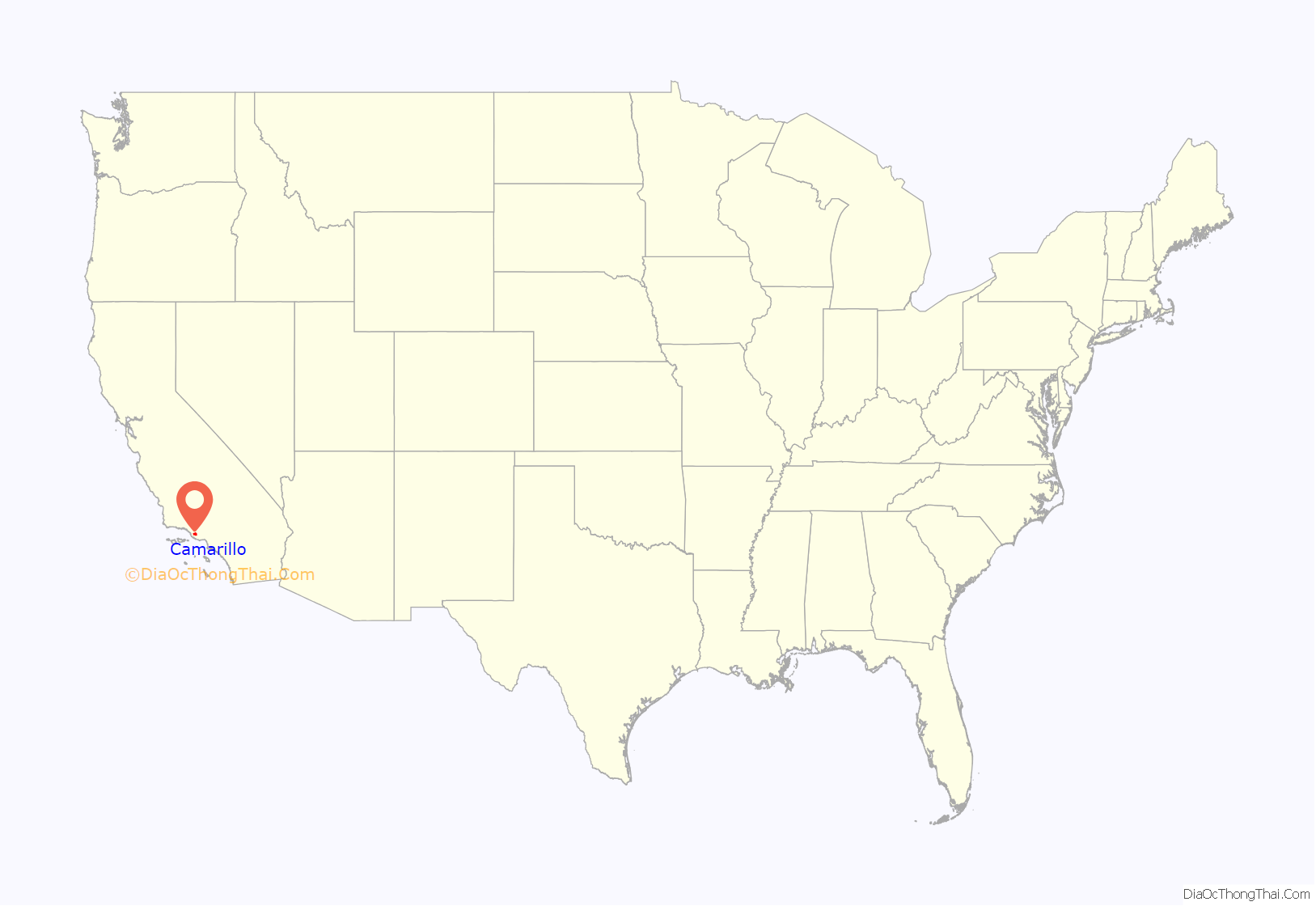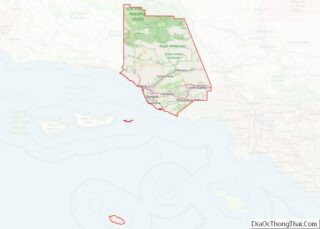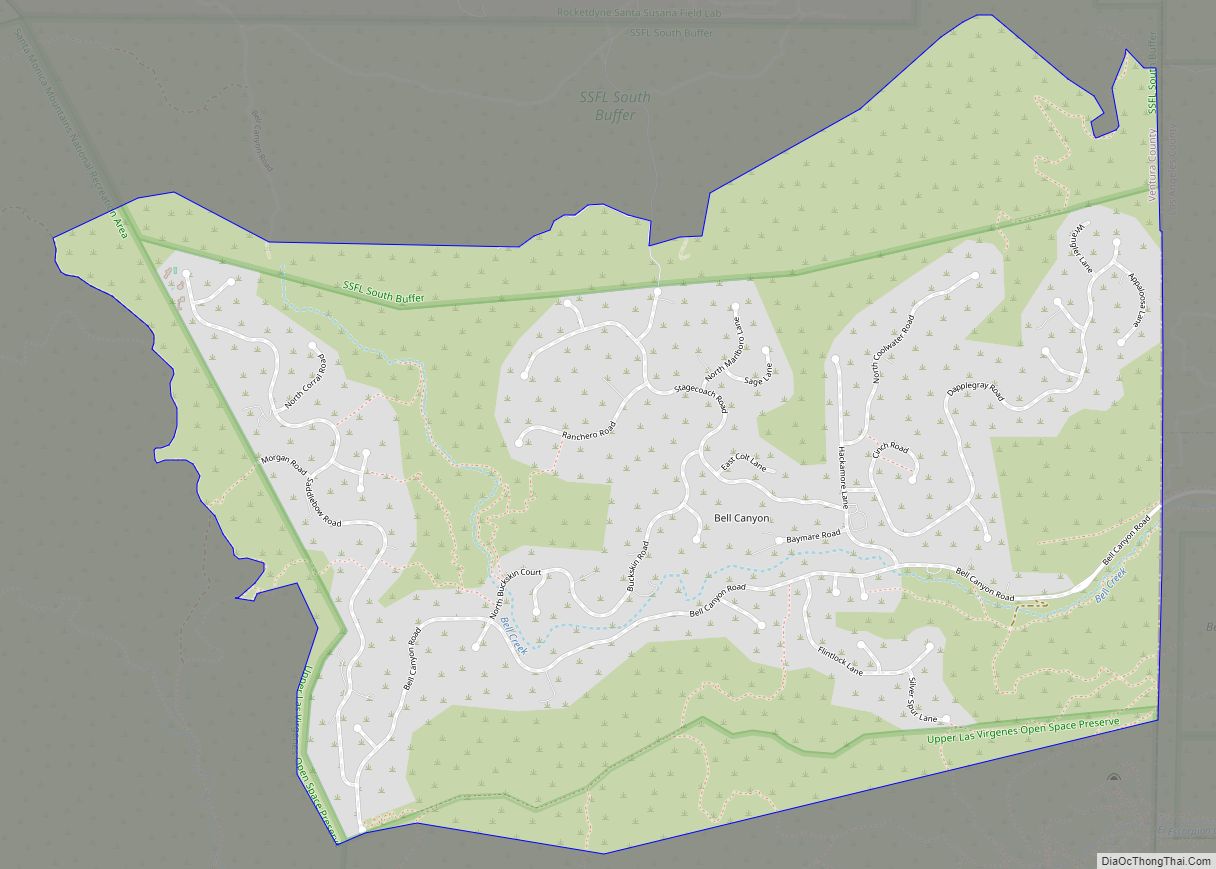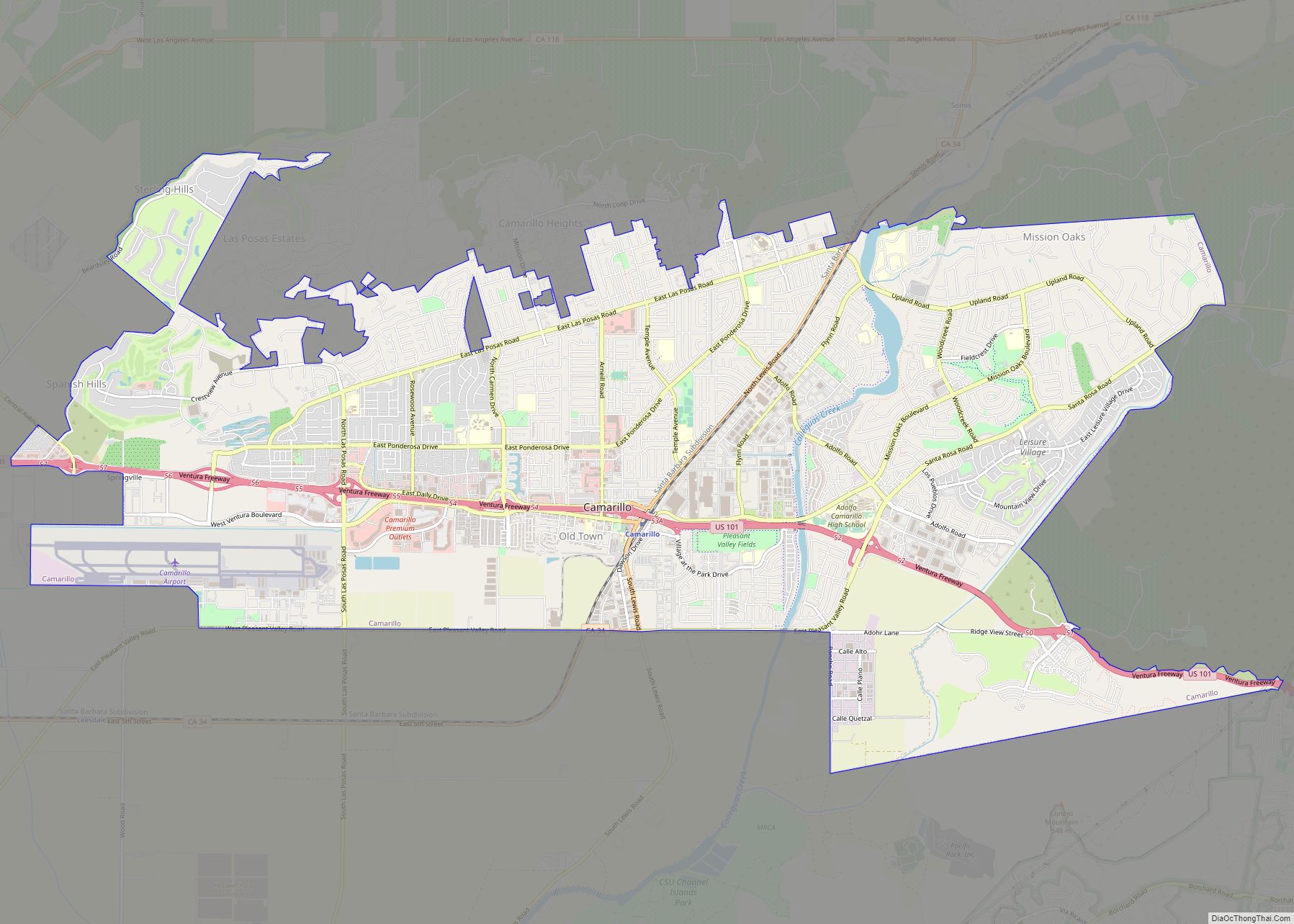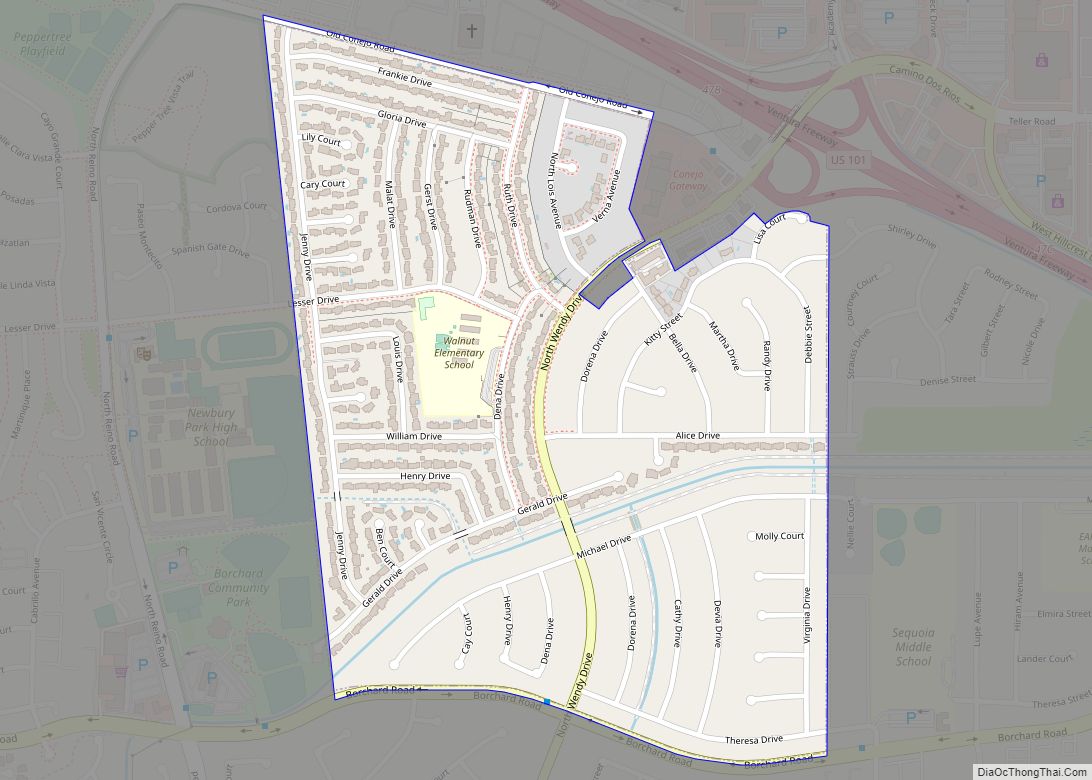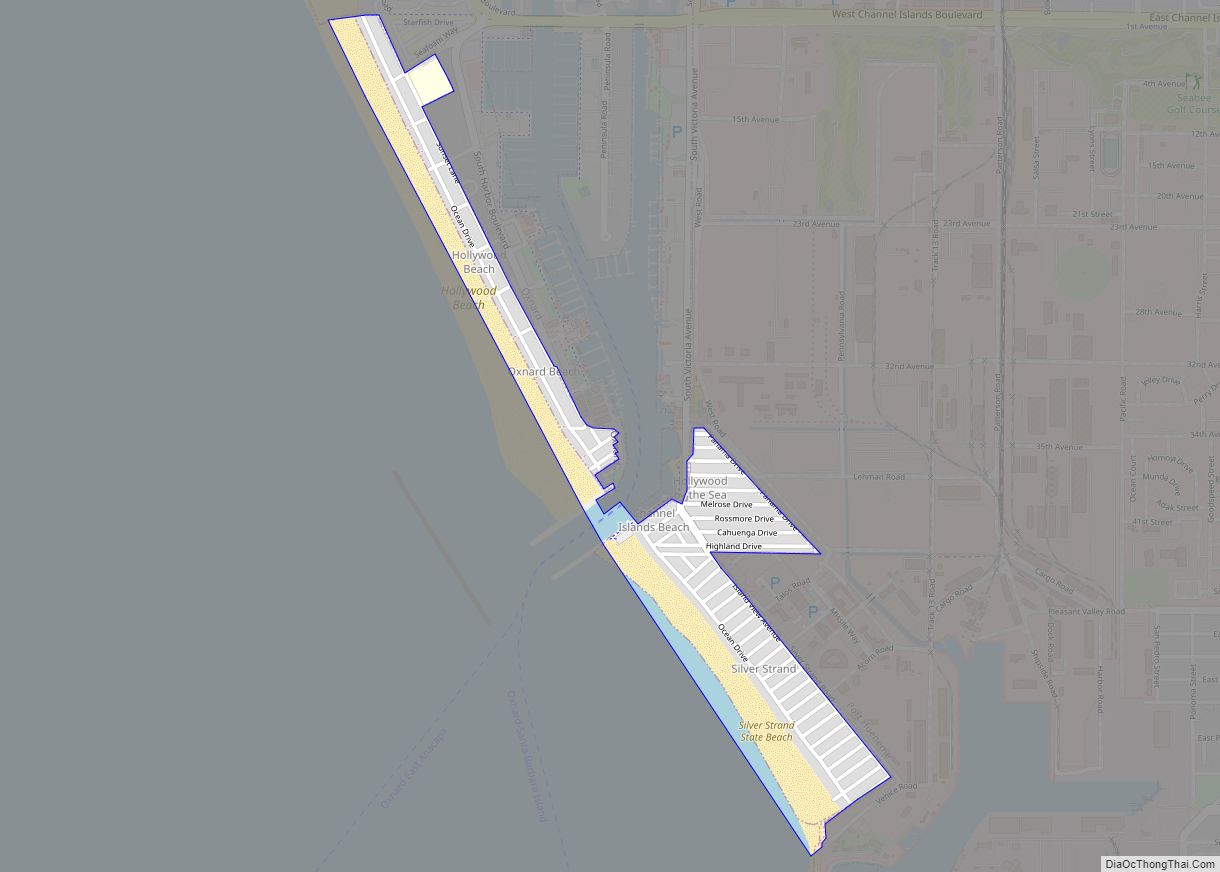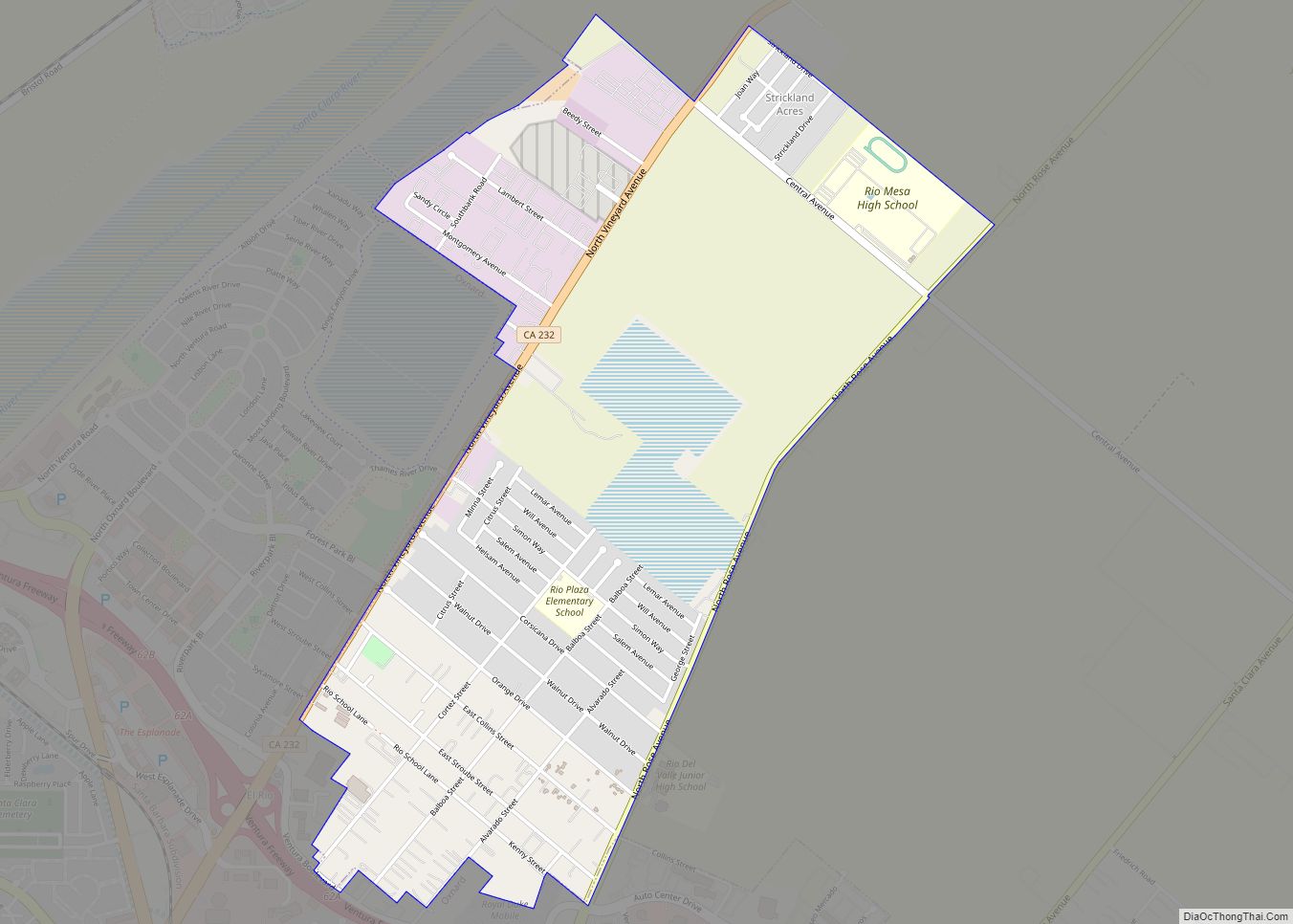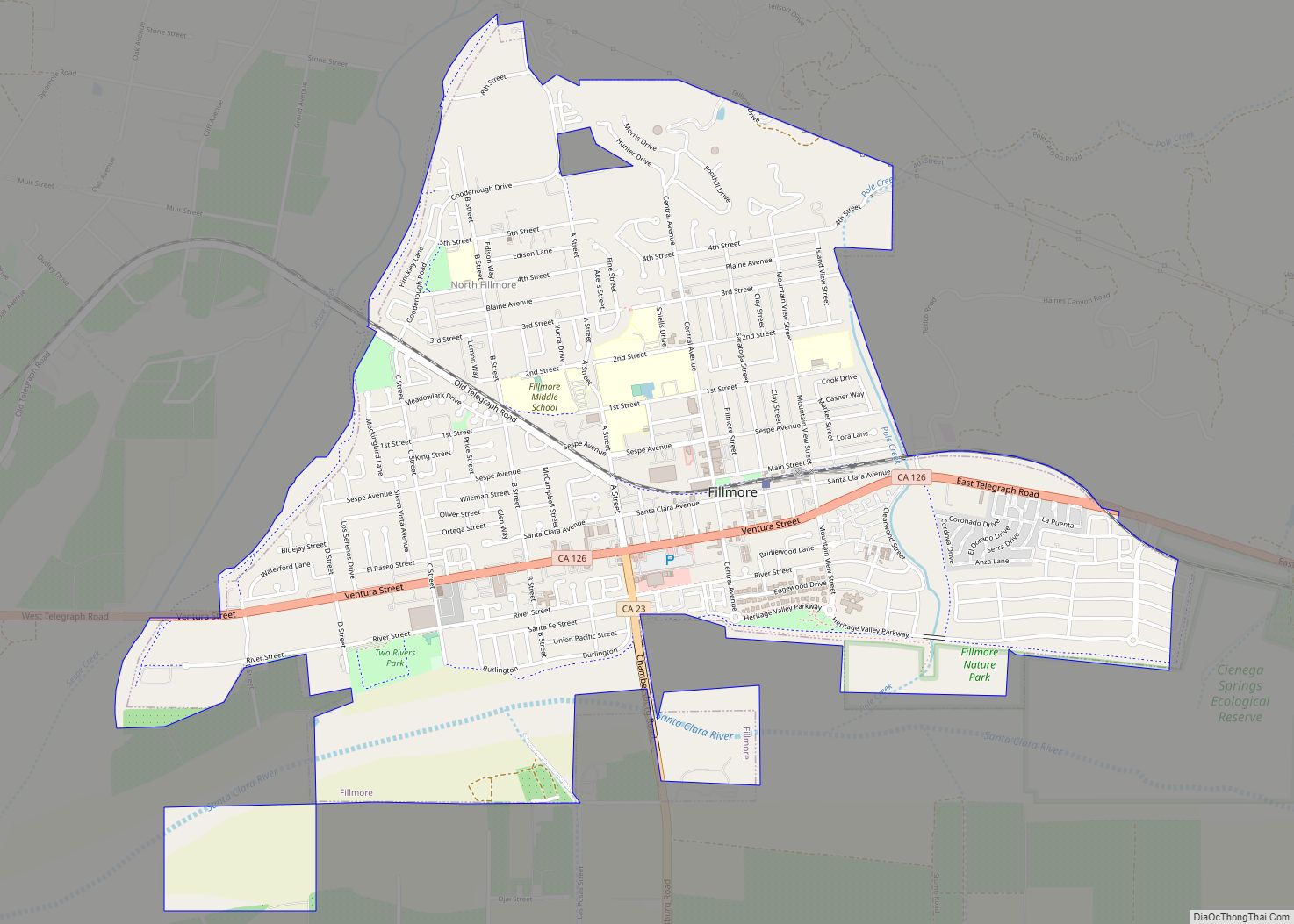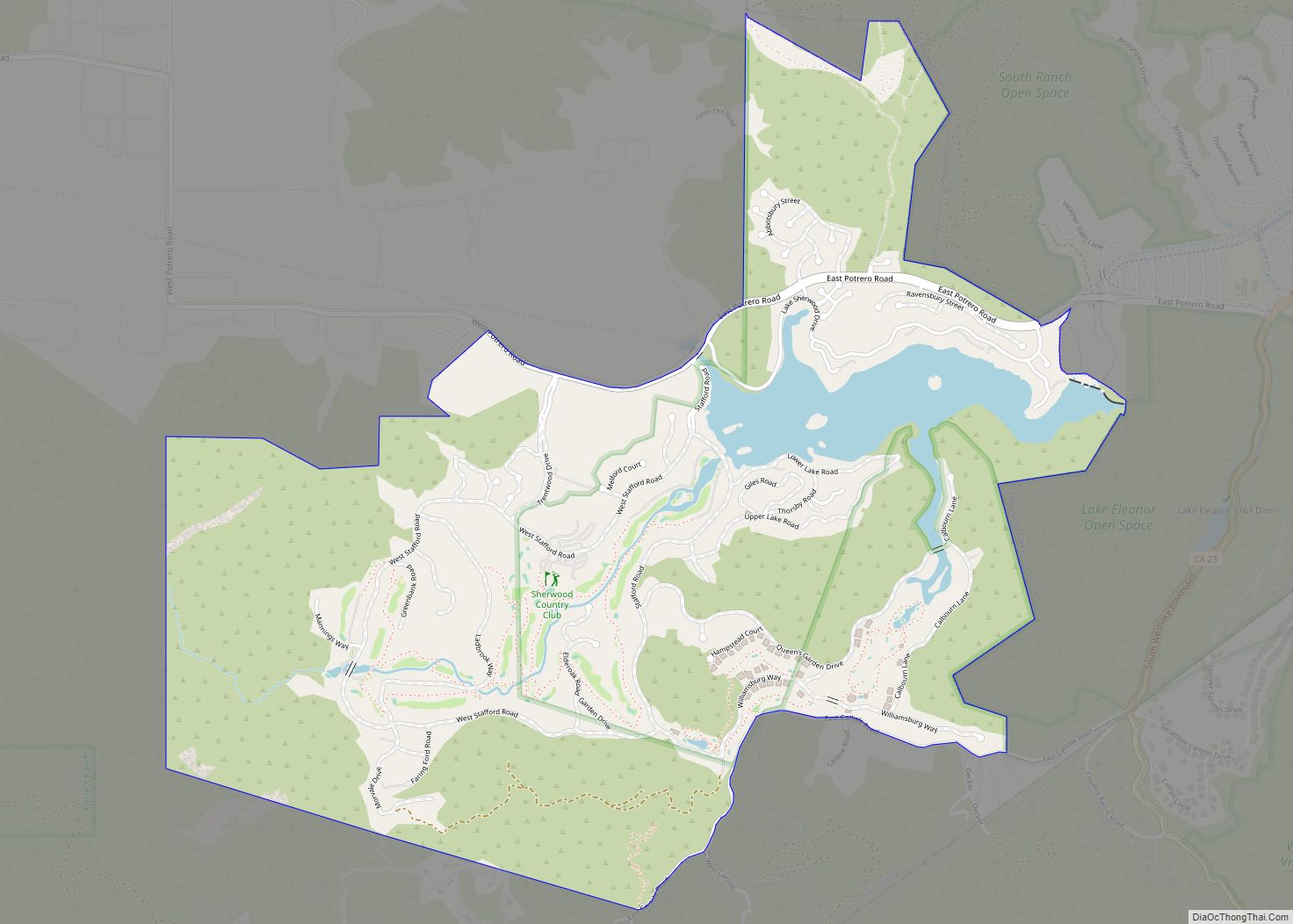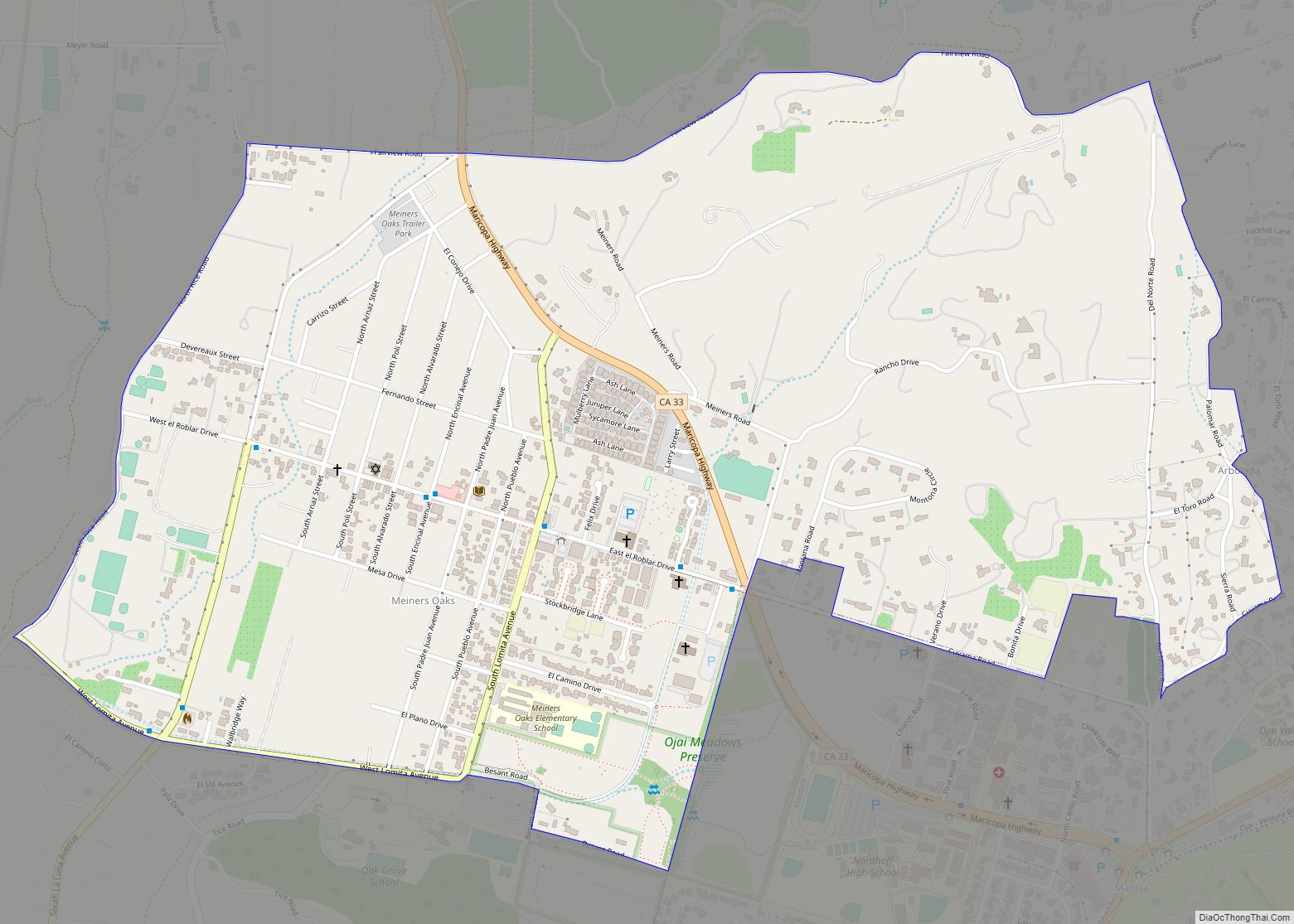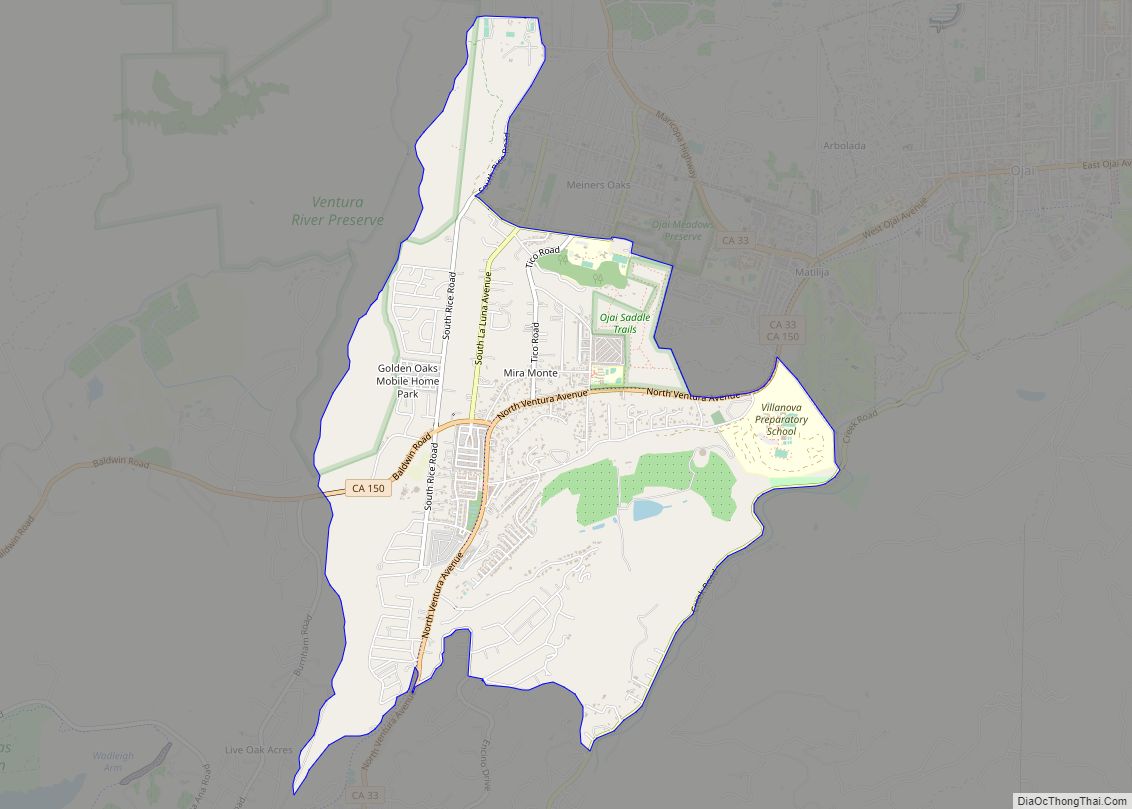Camarillo (/ˌkæməˈriːoʊ/ (listen) KAM-ə-REE-oh) is a city in Ventura County in the U.S. state of California. As of the 2020 United States Census, the population was 70,741, an increase of 5,540 from the 65,201 counted in the 2010 Census. Camarillo is named for brothers Juan and Adolfo Camarillo, prominent Californios who owned Rancho Calleguas and founded the city. California State University, Channel Islands is housed on the former grounds of the Camarillo State Hospital.
| Name: | Camarillo city |
|---|---|
| LSAD Code: | 25 |
| LSAD Description: | city (suffix) |
| State: | California |
| County: | Ventura County |
| Incorporated: | October 22, 1964 |
| Elevation: | 177 ft (54 m) |
| Total Area: | 19.70 sq mi (51.03 km²) |
| Land Area: | 19.69 sq mi (50.99 km²) |
| Water Area: | 0.02 sq mi (0.04 km²) 0.08% |
| Total Population: | 70,741 |
| Population Density: | 3,593.47/sq mi (1,387.45/km²) |
| Area code: | 805 |
| FIPS code: | 0610046 |
| Website: | www.cityofcamarillo.org |
Online Interactive Map
Click on ![]() to view map in "full screen" mode.
to view map in "full screen" mode.
Camarillo location map. Where is Camarillo city?
History
At the time of European contact in the 18th century, Camarillo had been inhabited by the Chumash Indians for thousands of years.
Present day Camarillo and the larger Oxnard Plain were portions of a paramount Chumash capital at the village of Muwu (today’s Point Mugu). Simo’mo (CA-VEN-24), which translates to “the saltbush patch”, was a Chumash village located upstream from Mugu Lagoon near the city of Camarillo. Caves with ancient pictographs are located in the area around Conejo Grade including a site used for religious ceremonies dating back to 500 A.D., where two Chumash villages were located: Lalimanux (Lalimanuc or Lalimanuh) and Kayɨwɨš or Kayiwish (Kawyis) (CA-VEN-243). The village of Kayɨwɨš (Chumash: “The Head”) was first encountered by Europeans of the first Portola expedition on August 16, 1795.
19th century
By the early 1820s, Mexico had gained independence from Spain, and shortly afterward California allied itself with Mexico. The Mexican land grant system was liberalized in 1824, resulting in many large grants in California and the proliferation of Ranchos north of the border. One grant to José Pedro Ruiz created Rancho Calleguas in 1837, in the area that is now Camarillo. The grant was later sold to Juan Camarillo, who had arrived in 1834 as a member of the Híjar-Padrés colony; it was his sons Adolfo and Juan that are credited with the founding of the town that was to bear their name.
Early 20th century
Around 1910, the area for the original town site of Camarillo was beginning to be laid out. The town was centered around St. Mary Magdalen Church, which was to serve as the family chapel for Adolfo Camarillo. In 1927 Don Juan Camarillo, brother of Adolfo, donated 100 acres (0.40 km) to be used as a seminary to be named in honor of Saint John the Evangelist. The Roman Catholic seminary was opened in 1939 as St. John’s Seminary.
Camarillo’s growth was slow from founding through World War II. In the late 1940s, building lots on Ventura Boulevard, the main downtown street, were being offered for $450 and home lots on the adjoining streets were $250, with few buyers. Travel to and from Los Angeles was difficult, owing to the narrow, tortuous road climbing the Conejo Grade to the east of the city.
The main industry during this period was agriculture, and the area surrounding the small town was blanketed with orange, lemon and walnut groves. The State Mental hospital, that was built south of the town, was the largest employer. A few houses had sprung up to the north and south of town center. The Oxnard Army Air Field, built during World War II to the west of town, the Naval Air Facility at Point Mugu and the Seabee base at Port Hueneme brought many military personnel to the area, but there was little private industry or other source of non-agricultural employment.
Oxnard AAF closed at the end of World War II, but the Navy facilities remained open, with the airfield upgraded to Naval Air Station Point Mugu and the Seabee base becoming Naval Construction Battalion Center Port Hueneme and Naval Surface Warfare Center Port Hueneme. With the Korean War and associated Cold War tensions, the former Oxnard AAF was reactivated in 1951 as Oxnard Air Force Base, an Air Defense Command / Aerospace Defense Command fighter-interceptor base, that closed again in 1970 and became the present-day Camarillo Airport.
In the mid-1950s, the Ventura Freeway was completed from Los Angeles to points north, making it an easy one-hour trip to Camarillo. The Old Town was bisect by the Ventura Freeway. On the southern side of the freeway contains a strip of businesses, churches, schools, and parks. The freeway was originally planned to follow the path of Potrero Road, south of Camarillo, which would have completely by-passed the soon-to-be city. However, after much debate, city officials persuaded Caltrans to lay the freeway parallel to Ventura Boulevard, creating the infamously steep descent from the Santa Monica Mountains, known as the Conejo Grade. The grade is about 2.7 miles (4.3 km) and posted as a 7% grade—which translates as about one thousand feet of elevation change in less than three miles (70 meters per kilometer). There is a California Highway Patrol brake inspection station at the top of the grade and a stop is mandatory for all 18-wheel trucks. The completion of the freeway facilitated the growth that followed. In 1962, the population was 7,500 and 3M began construction for the Mincom and Magnetic Tape Divisions, which would ultimately employ 900 people, becoming the largest local employer. That plant briefly housed a factory for 3M spinoff Imation before being closed in 2008.
Incorporation
Plans were made for the incorporation of the city to control the rapid expansion. Camarillo became a city in 1964 and soon put into place a General Plan and building codes. In 1964 the closest traffic signal was 2 miles (3.2 km) from the city center on the road to Point Mugu, and the first shopping center and supermarket were under construction.
Many of the home buyers during the 1960s were military veterans, who had been stationed at one of the local bases. The temperate climate and the living conditions lured them back. With the establishment of both the Pacific Missile Range at NAS Point Mugu and the Naval Civil Engineering Laboratory at Port Hueneme many found employment that utilized their military training. Other newcomers were those who worked and lived in the San Fernando Valley and were willing to endure the commute for the opportunity to raise their families in a smog-free, semirural environment. Still others relocated here with their employers, like 3M, and Harbor Freight Tools who built facilities in and around the city to take advantage of the large workforce. Technicolor Video Services Inc. was the largest DVD duplicator in the world.
In 2014, the council voted against an 895-acre project (362 ha) that would have extended development on agricultural lands east towards the Conejo Grade.
Beginning 7:02 am. on Thursday, May 2, 2013, a major brush fire began in the Camarillo Springs area and burned throughout the area. The community of Dos Vientos and CSUCI were evacuated due to the proximity of the fire. About 15 houses were damaged, but none burned down. 28,000 acres of land was burned by the fire. Finally, on Sunday, May 5, 2013, rain in the area during the night helped firefighters bring the fire under full control.
Camarillo Road Map
Camarillo city Satellite Map
Geography
According to the United States Census Bureau, the city has a total area of 19.5 square miles (51 km). 0.015 square miles (0.039 km) of the area (0.08%) is water.
Camarillo is located in Pleasant Valley at the eastern end of the Oxnard Plain, with the Santa Susana Mountains to the north, the Camarillo Hills to the northwest, the Conejo Valley to the east, and the western reaches of the Santa Monica Mountains to the south.
Climate
This region experiences warm (but not hot) and dry summers, with no average monthly temperatures above 71.6 °F (22.0 °C). According to the Köppen Climate Classification system, Camarillo has a warm-summer Mediterranean climate, abbreviated “Csb” on climate maps.
See also
Map of California State and its subdivision:- Alameda
- Alpine
- Amador
- Butte
- Calaveras
- Colusa
- Contra Costa
- Del Norte
- El Dorado
- Fresno
- Glenn
- Humboldt
- Imperial
- Inyo
- Kern
- Kings
- Lake
- Lassen
- Los Angeles
- Madera
- Marin
- Mariposa
- Mendocino
- Merced
- Modoc
- Mono
- Monterey
- Napa
- Nevada
- Orange
- Placer
- Plumas
- Riverside
- Sacramento
- San Benito
- San Bernardino
- San Diego
- San Francisco
- San Joaquin
- San Luis Obispo
- San Mateo
- Santa Barbara
- Santa Clara
- Santa Cruz
- Shasta
- Sierra
- Siskiyou
- Solano
- Sonoma
- Stanislaus
- Sutter
- Tehama
- Trinity
- Tulare
- Tuolumne
- Ventura
- Yolo
- Yuba
- Alabama
- Alaska
- Arizona
- Arkansas
- California
- Colorado
- Connecticut
- Delaware
- District of Columbia
- Florida
- Georgia
- Hawaii
- Idaho
- Illinois
- Indiana
- Iowa
- Kansas
- Kentucky
- Louisiana
- Maine
- Maryland
- Massachusetts
- Michigan
- Minnesota
- Mississippi
- Missouri
- Montana
- Nebraska
- Nevada
- New Hampshire
- New Jersey
- New Mexico
- New York
- North Carolina
- North Dakota
- Ohio
- Oklahoma
- Oregon
- Pennsylvania
- Rhode Island
- South Carolina
- South Dakota
- Tennessee
- Texas
- Utah
- Vermont
- Virginia
- Washington
- West Virginia
- Wisconsin
- Wyoming
